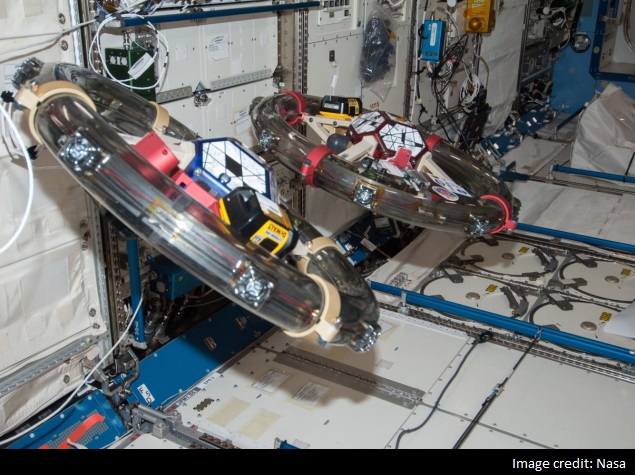- Home
- Science
- Science News
- Nasa to Power ISS Robots With Google's Project Tango 3D Smartphones
Nasa to Power ISS Robots With Google's Project Tango 3D Smartphones

Nasa plans to use the handsets to beef up its Synchronized Position Hold, Engage, Reorient, Experimental Satellites, or SPHERES, which could eventually take over daily chores for astronauts or even handle risky duties outside of the vessel.
The phones, part of Google's Project Tango augmented reality initiative, will be aboard a cargo spacecraft scheduled to launch on July 11.
Inspired by a scene from the movie Star Wars where Luke Skywalker spars with a hovering globe, the soccer-ball sized robots can be guided around the space station's microgravity interior, propelled by tiny blasts of CO2 at about an inch per second.
When Nasa sent its SPHERES to the space station in 2006 they were capable of precise movement but little else. In 2010, engineers at Nasa's Ames Research Center in Mountain View, California, looked for ways to make the devices smarter.
"We wanted to add communication, a camera, increase the processing capability, accelerometers and other sensors. As we were scratching our heads thinking about what to do, we realized the answer was in our hands," Smart SPHERES project manager Chris Provencher told Reuters in an interview last week. "Let's just use smartphones."
They bought phones at Best Buy and altered them by adding extra batteries and a shatter-proof displays before sending the handsets to the space station, where astronauts used Velcro to attach them to the side of the SPHERES. That gave the robots a wealth of new sensing and visual capabilities - but still not enough to move around the station as easily as the engineers wanted.
Looking to improve the robots, Nasa recently turned to the experimental smartphones Google created to encourage innovation in its push for consumer mobile devices that can make sense of space as easily as people do.
The Project Tango handsets include a motion-tracking camera and an infrared depth sensor similar to Microsoft's Kinect add-on for the Xbox. The sensors will detect sharp angles inside the space station and create a 3D map that lets the SPHERES navigate from one module to another.
(Also see: Google 'Project Tango' 3D vision smartphone platform announced)
"This type of capability is exactly what we need for a robot that's going to do tasks anywhere inside the space station," Provencher said. "It has to have a very robust navigation system."
Nasa's phones have been split open so that the touchscreen and sensors face outward when mounted on the robots. They also include space-tested batteries and plastic connectors to replace the Velcro.
Google wants the technology showcased by Project Tango to become ubiquitous, helping retailers create detailed 3D representations of their shops and letting gamers make their homes into virtual battlegrounds.
It also teamed up with LG recently to launch a Project Tango tablet to encourage developers to experiment with its features.
© Thomson Reuters 2014
For the latest tech news and reviews, follow Gadgets 360 on X, Facebook, WhatsApp, Threads and Google News. For the latest videos on gadgets and tech, subscribe to our YouTube channel. If you want to know everything about top influencers, follow our in-house Who'sThat360 on Instagram and YouTube.
Related Stories
- Samsung Galaxy Unpacked 2025
- ChatGPT
- Redmi Note 14 Pro+
- iPhone 16
- Apple Vision Pro
- Oneplus 12
- OnePlus Nord CE 3 Lite 5G
- iPhone 13
- Xiaomi 14 Pro
- Oppo Find N3
- Tecno Spark Go (2023)
- Realme V30
- Best Phones Under 25000
- Samsung Galaxy S24 Series
- Cryptocurrency
- iQoo 12
- Samsung Galaxy S24 Ultra
- Giottus
- Samsung Galaxy Z Flip 5
- Apple 'Scary Fast'
- Housefull 5
- GoPro Hero 12 Black Review
- Invincible Season 2
- JioGlass
- HD Ready TV
- Laptop Under 50000
- Smartwatch Under 10000
- Latest Mobile Phones
- Compare Phones
- Samsung Galaxy F16 5G
- iQOO Neo 10R
- Tecno Camon 40 Premier 5G
- Infinix Note 50 Pro+
- Infinix Note 50 Pro
- Infinix Note 50
- Vivo T4x 5G
- Nubia Neo 3 GT 5G
- Asus Zenbook A14 (UX3407RA)
- Tecno Megabook S14
- Lenovo Tab K9
- Apple iPad (2025) Wi-Fi + Cellular
- boAt Ultima Prime
- boAt Ultima Ember
- Haier M95E
- Sony 65 Inches Ultra HD (4K) LED Smart TV (KD-65X74L)
- Sony PlayStation 5 Pro
- Sony PlayStation 5 Slim Digital Edition
- Blue Star 1.5 Ton 3 Star Inverter Split AC (IC318DNUHC)
- Blue Star 1.5 Ton 3 Star Inverter Split AC (IA318VKU)

















